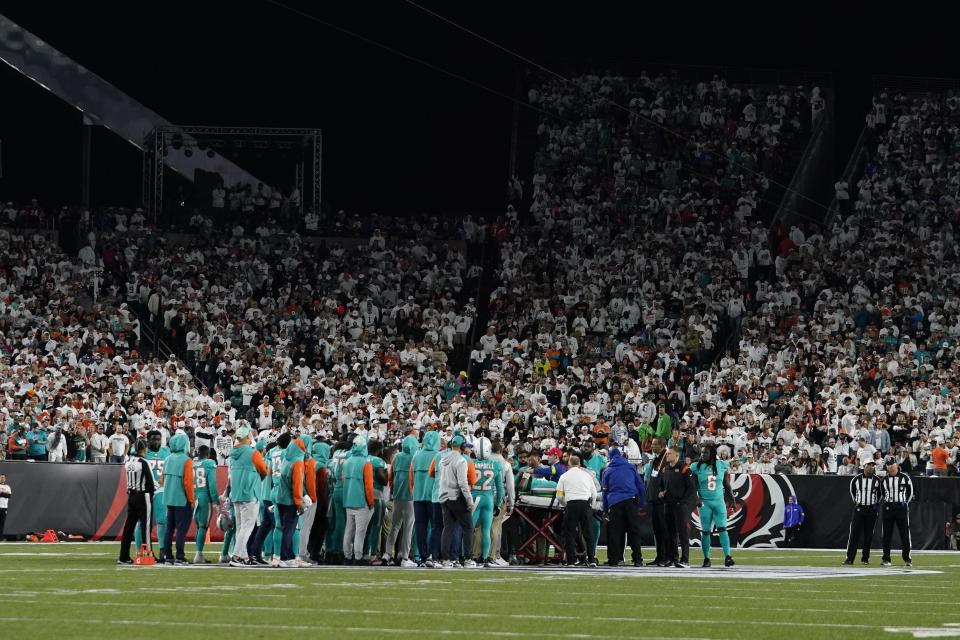Tua Tagovailoa's scary head injury puts NFL's concussion protocol under fire. What are the league rules?
- Oops!Something went wrong.Please try again later.
In the wake of the head injury suffered by Tua Tagovailoa during Thursday night's game at Cincinnati, the sports world has been abuzz about whether the Miami Dolphins quarterback even should have been playing after suffering a similar injury four days earlier.
Although reporters initially were told Tagovailoa suffered a head injury on Sunday on the second-quarter play when illegally hit by Bills linebacker Matt Milano, it was later changed to back and ankle problems. He returned to the game at the start of the second half and helped Miami stun Buffalo.
While that injury and subsequent actions remain under investigation by the NFL Players Association, Tagovailoa definitely suffered a concussion Thursday when slammed to the ground by Bengals defensive tackle Josh Tupou in the second quarter.
McDaniel on Tua: Tagovailoa had no concussion until Thursday, but games are secondary now
Dolphins suffer first loss: 5 Instant Takeaways: Miami Dolphins lose to Cincinnati Bengals | Schad
So, here is a primer on what is a concussion and what makes up the National Football League's concussion protocol:
Not every concussion is the same
Dr. Michael Dakkak is a sports medicine physician for Cleveland Clinic Florida in Broward County. He is part of a program that evaluates retired NFL players for post-concussion issues. He declined to speak about Tagovailoa's injury, but spoke in general terms about concussions and head injuries.
He stressed that treatment for concussions can vary from player to player.
"Each concussion is different," he said. "There's not a cookie cutter way to recover from one and the symptoms that a player may experience are not the same each time. I've seen concussions where it just affects mood and then others where it only affects vision, people just have headaches that keep recurring or others where there's a combination of all those things.
"There's not one thing that's consistent with concussions in terms of the physical manifestation. But I do think that it's imperative (that you have) early recognition and removal from play if there's any concern is highly recommended and would be the best way to promote recovery."
Dakkar said there is no hard and fast timeline in terms of recovery, with times ranging from a few days to a few months depending on the severity.
NFL's concussion protocol
The NFL established its concussion protocol in 2011 with the goal of making sure players are getting the most valuable information when it comes to the diagnosis and treatment of concussions. The protocol was developed by an independent board and league physicians and scientists, including NFLPA advisers, better known as the head, neck and spine committee. It was amended in 2020.
Once a player is feared to have a head injury, they're mandated to be taken off the field of play immediately and examined in a medical tent on the sideline to assess the injury. The player can only return to the game if cleared by a doctor. There also are spotters in the stands who can flag a player on the field if they think he's exhibiting signs of a concussion.
The sideline exam includes a cervical spine exam (including range of motion and pain), an evaluation of speech, observation of gait, and an eye movement and pupillary exam. If the player displays signs of any loss of consciousness, gross motor inability, confusion or amnesia, team medical staff are not permitted to let the player return to action.
Once a player enters the concussion protocol, here are the five steps to returning to playing status:
Phase 1: Symptom-limited activity
The player is prescribed rest, limiting, or if necessary, avoiding activities that increase or aggravate symptoms. Under athletic training staff supervision, limited stretching and balance training can be introduced, progressing to light aerobic exercise, all as tolerated.

If the player doesn't have an increase in symptoms and does not demonstrate signs of a concussion during a neurological examination, they may be cleared to move on to the next phase.
Phase 2: Aerobic exercise
Under the supervision of team staff, players should begin graduated cardiovascular exercise and may also engage in dynamic stretching and balancing training. If the player demonstrates the ability to engage in cardiovascular exercise without an increase or aggravation of symptoms, they move on to the next phase.
Phase 3: Football-specific exercise
The player continues supervised cardiovascular exercises that are increased and may mimic sport-specific activities, and supervised strength training is introduced.
Phase 4: Non-contact training drills
The player is encouraged to continue cardiovascular, strength and balance training, team-based sports-specific exercise and participate in non-contact football activities.
Phase 5: Full football activity/clearance
The player is finally cleared by the club doctor for full football activity involving contact. The player must be examined by the independent neurological consultant assigned to his club. If the consultant agrees with the club physician that the player’s concussion has been resolved, then the player can participate in practice and contact without restriction.
Since every player and concussion is unique, there is no set time frame for returning to the field. Team medical staff consider the player’s current concussive injury, past exposures and medical history, family history and future risk in managing a player’s care.
Until the player is cleared by the independent consultant, he may not return to contact practice or play in an NFL game.
Information from the NFL and Wires was used in this report.
This article originally appeared on Palm Beach Post: Tua Tagovailoa's head injury has put focus on NFL concussion protocol

